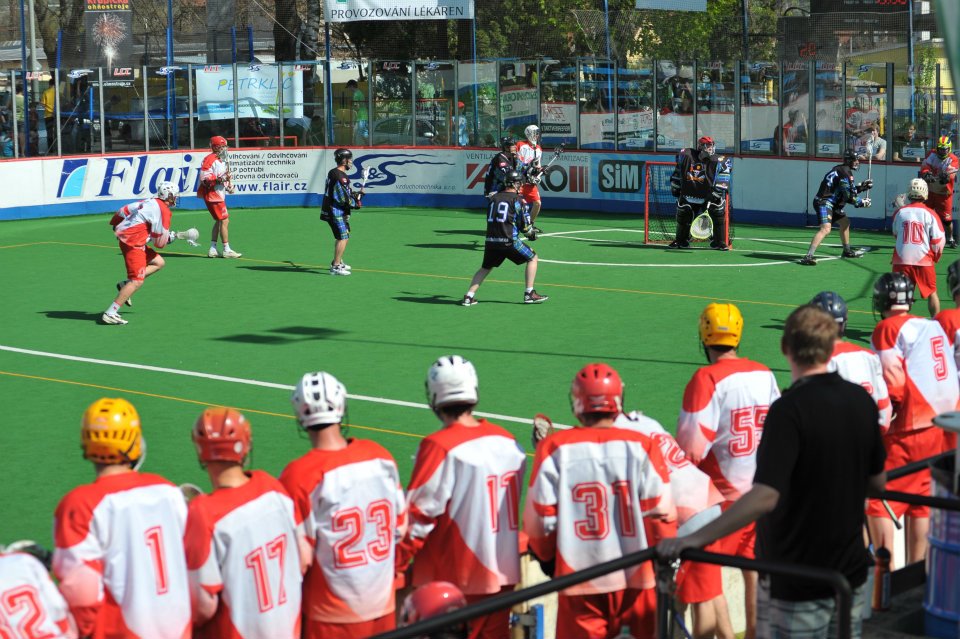Tactics Analysis:
Short Handed
- The box is structured to defend both crease offenders and both shooters, with the two high defenders' also splitting the point player (or the player in the middle if the powerplay is in a 2-1-2). Should the point player attempt to shoot, both defenders should “pinch” tight together, trying to block the shot.
When one of the shooters cuts through the middle, it is also the off-ball “high” defenders responsibility to follow the "cutter," eventually “passing them off” to the on-ball low defender. The “low” defenders’ major responsibility is to lock-off the creases, with all defenders keeping their sticks and bodies in the shooting and passing lanes.
Generally, the “high” defenders’ sticks are towards the middle, and the low defenders’ sticks are towards the boards, in order to best defend these lanes. Although, if either "shooter" on the power-play is a significant play maker, it may warrant the high defenders' stick being on the outside (board-side).
-
-
- The diamond is structured to directly cover the point and both shooter positions, with one defender splitting both crease players down low, playing “cat & mouse.”
-
This defense is designed to invite shots from the crease players and take away the shots of the offenders up high. Defenders must be careful not to get over-extended, leaving too much space in the middle.
The goalie usually plays back closer to the goal-line (“deep” in the net) to eliminate the angles for quick stick opportunities at the crease. The two defenders at the side of the diamond should also have their sticks toward the middle, in order to better defend the passing lanes to the crease players.
-
-
-
- The triangle can be played with two defenders high and one defender low (2 up, 1 back), vice-versa, or a mixture of both (Inverted Triangle). Playing two defenders up high invites the crease players to shoot and vice-versa (1 up, 2 back) invites the shooters to shoot.
-
-
In the latter case, the “low” defenders need to lock off the “crease players,” allowing the goalies to come out and challenge the shooters. With two defenders high, the low defender must be able to deter quick sticks from one crease player to the other (“crease-to-crease”), while also playing “cat & mouse” and communicating with the goalie.
Short-Handed Execution
-
-
-
-
- It is important that all players know the situation and which zone defense is to be played, prior to getting on the floor; also any “assignments,” if required. If the other team is consistently successful against a certain zone (i.e. box vs. diamond), it is also important that coaches are ready to make adjustments. Teams may further switch up the zone being played simply to disrupt the other team’s offensive flow.
-
-
-
Players should always have their sticks up with their bodies in the shooting lanes, also aware of what is happening off-ball (head on a swivel). Defensive players need to recognize picks/seals, drags, cutters, fillers and players behind the net; communicating amongst one another. As a general team rule, players should not move more than “three shuffle steps” at a time, depending on the zone being played and the ball movement of the opposing team. If one player slides out of desperation, every player should slide in that same direction ("go"), effectively changing which part of the zone they are defending.
The Goaltender is essentially the biggest difference maker while short-handed, as they are the cornerstone of any defense. Loose balls are amply important, with the goaltender playing the most significant role via rebound control. Defenders also have a huge responsibility in this aspect as well, being sure to box-out after all shots (especially the low defenders). Instead of battling for rebounds in front of the net, it is usually better to just take a minor interference call, rather than allow the opposing team to pick-up a loose ball and potentially score.
Defenders need to make split-second decisions as to whether or not to pursue loose balls, some of which could potentially leave them out of position if they don’t get there first (50-50 balls). If a teammate does happen to obtain possession of the ball, defenders should run the ball up the floor “in two’s,” with all others running hard to the bench for a line change (a full change would be ideal; thus sparing the energy of the premiere penalty killers).
- Categories: Free / Playbook / Beginner / Short Handed
